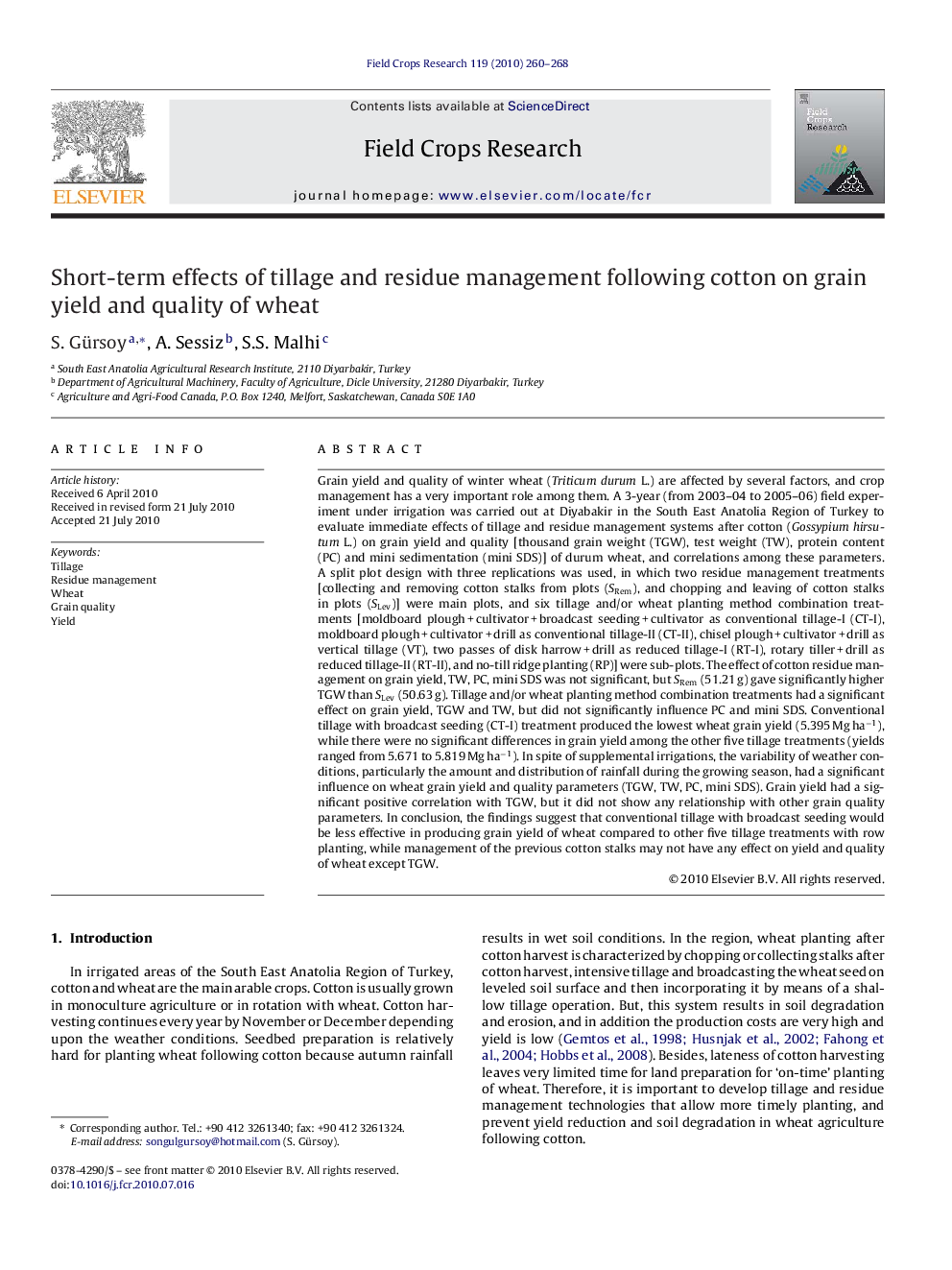| کد مقاله | کد نشریه | سال انتشار | مقاله انگلیسی | نسخه تمام متن |
|---|---|---|---|---|
| 4510890 | 1624740 | 2010 | 9 صفحه PDF | دانلود رایگان |
عنوان انگلیسی مقاله ISI
Short-term effects of tillage and residue management following cotton on grain yield and quality of wheat
دانلود مقاله + سفارش ترجمه
دانلود مقاله ISI انگلیسی
رایگان برای ایرانیان
کلمات کلیدی
موضوعات مرتبط
علوم زیستی و بیوفناوری
علوم کشاورزی و بیولوژیک
علوم زراعت و اصلاح نباتات
پیش نمایش صفحه اول مقاله

چکیده انگلیسی
Grain yield and quality of winter wheat (Triticum durum L.) are affected by several factors, and crop management has a very important role among them. A 3-year (from 2003-04 to 2005-06) field experiment under irrigation was carried out at Diyabakir in the South East Anatolia Region of Turkey to evaluate immediate effects of tillage and residue management systems after cotton (Gossypium hirsutum L.) on grain yield and quality [thousand grain weight (TGW), test weight (TW), protein content (PC) and mini sedimentation (mini SDS)] of durum wheat, and correlations among these parameters. A split plot design with three replications was used, in which two residue management treatments [collecting and removing cotton stalks from plots (SRem), and chopping and leaving of cotton stalks in plots (SLev)] were main plots, and six tillage and/or wheat planting method combination treatments [moldboard plough + cultivator + broadcast seeding + cultivator as conventional tillage-I (CT-I), moldboard plough + cultivator + drill as conventional tillage-II (CT-II), chisel plough + cultivator + drill as vertical tillage (VT), two passes of disk harrow + drill as reduced tillage-I (RT-I), rotary tiller + drill as reduced tillage-II (RT-II), and no-till ridge planting (RP)] were sub-plots. The effect of cotton residue management on grain yield, TW, PC, mini SDS was not significant, but SRem (51.21 g) gave significantly higher TGW than SLev (50.63 g). Tillage and/or wheat planting method combination treatments had a significant effect on grain yield, TGW and TW, but did not significantly influence PC and mini SDS. Conventional tillage with broadcast seeding (CT-I) treatment produced the lowest wheat grain yield (5.395 Mg haâ1), while there were no significant differences in grain yield among the other five tillage treatments (yields ranged from 5.671 to 5.819 Mg haâ1). In spite of supplemental irrigations, the variability of weather conditions, particularly the amount and distribution of rainfall during the growing season, had a significant influence on wheat grain yield and quality parameters (TGW, TW, PC, mini SDS). Grain yield had a significant positive correlation with TGW, but it did not show any relationship with other grain quality parameters. In conclusion, the findings suggest that conventional tillage with broadcast seeding would be less effective in producing grain yield of wheat compared to other five tillage treatments with row planting, while management of the previous cotton stalks may not have any effect on yield and quality of wheat except TGW.
ناشر
Database: Elsevier - ScienceDirect (ساینس دایرکت)
Journal: Field Crops Research - Volume 119, Issues 2â3, NovemberâDecember 2010, Pages 260-268
Journal: Field Crops Research - Volume 119, Issues 2â3, NovemberâDecember 2010, Pages 260-268
نویسندگان
S. Gürsoy, A. Sessiz, S.S. Malhi,